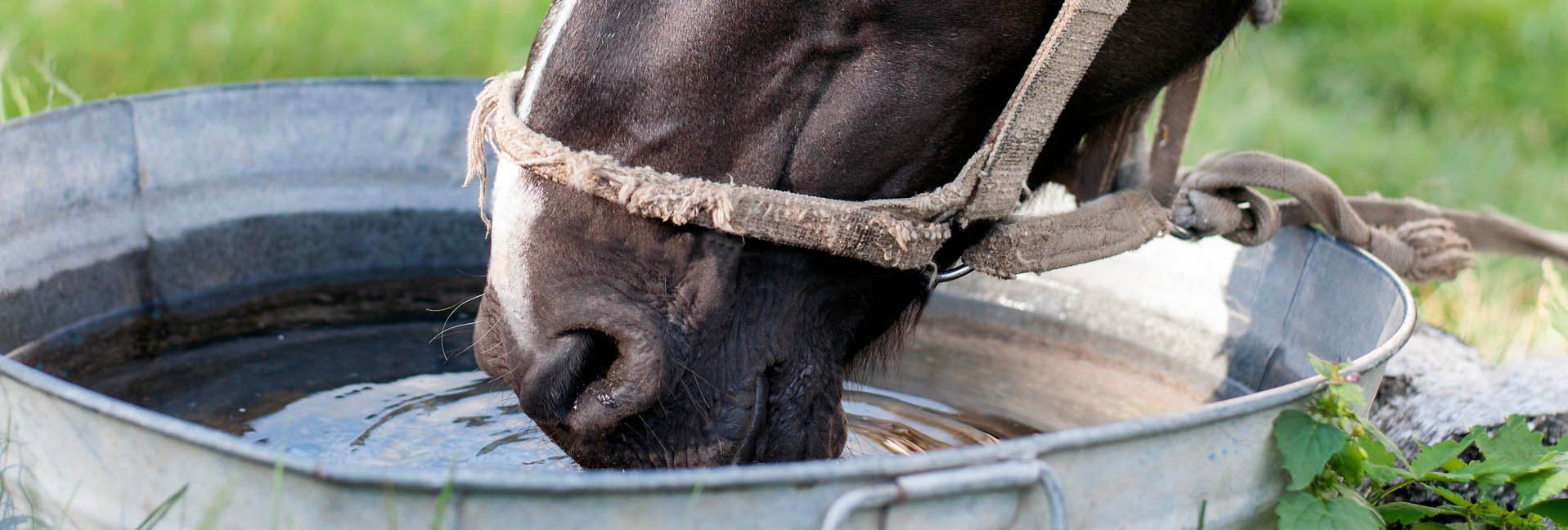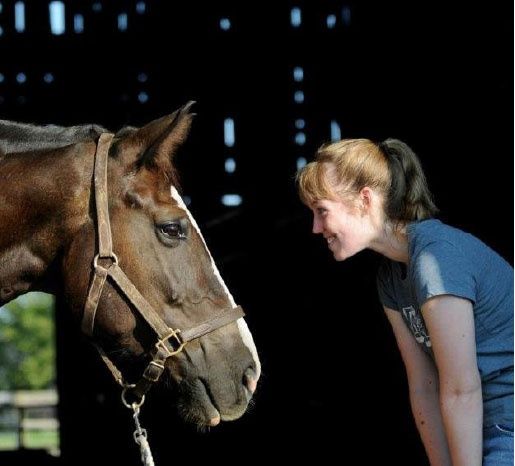Drink Up! Applying good sense to hydration


In the height of summer, you and your horse are sweating more than ever, whether you’re out on the trail or working around the barn. As you gulp down a bottle of water, you may be wondering—how can you be sure your horse is getting the hydration he needs?
The question of how much water a horse needs to stay hydrated is a complicated one. Heat and exercise obviously cause a horse to sweat and therefore require more water. One factor you may not think about is water lost through evaporation—a horse riding in a stock trailer at 65 miles per hour on a warm day is also losing water, because he’s sweating and the breeze is drying him out.
Another factor that many people overlook is diet. Dr. Laurie Lawrence, professor of equine nutrition at the University of Kentucky, said the amount of water in pasture has an influence on how much a horse needs or wants to drink.
“Free water intake can also be affected by the amount of water available in the food a horse consumes. For example, during the spring, fresh pasture will be quite high in water...possibly 70 or 80 percent,” said Lawrence. “So if a horse eats 20 pounds of fresh pasture a day, he will be consuming about 14 to 16 pounds of water in that pasture, and only about four to six pounds of actual dry matter which contains the nutrients. Because pasture is high in water, horses grazing an abundant pasture can consume 50 to 80 pounds of fresh pasture in 24-hour period. So that is around 35 to 65 pounds of water per day (or about a bucket and a half). It sometimes seems strange, but horses on pasture in the spring will have lower free water consumption than horses getting a diet of hay and grain in the winter.”
On average, a typical horse will drink four to nine gallons of water per day, absent additional stresses increasing their water needs.
Equine preferences?
So, how do you know if your horse is actually getting the hydration he needs?
If you have automatic waterers, it’s going to be pretty difficult to tell. Although buckets and troughs are more work to keep clean and filled, they do give you a good idea of how many gallons he’s getting per day, especially if they have volume markers. Remember that horses are more likely to drink clean, fresh water.
Ever noticed your horse is more interested in drinking in one place (in the stall or in the field), but not the other? We’re not sure why horses develop preferences like that if water is clean and available in both places (other than to worry anxious owners), but it’s not entirely unusual.
“Occasionally I have noticed that some buckets may be too deep or narrow for a horse to drink comfortably, so that could be a cause. And no doubt there are some taste preferences,” she said. “But if the horse is going to be inside a lot then it is a good idea to make sure they are comfortable drinking inside. That could mean trying a flavoring or placing the waterer in a different place, or even using an old bucket instead of a new one that might not smell good to them.”
I’ve been told apple juice is an enticing flavoring for water. There’s also a product on the market called Horse Quencher (which comes in a range of flavors), which is a dry product sprinkled into the water.
Yes or no to electrolytes?
Another trick many people will use to encourage their horses to drink is to dose them with electrolyte paste or add electrolytes or salts to their grain. Lawrence said there is conflicting evidence on whether this actually results in increased hydration. Some studies have shown sodium and potassium intake are closely related to water intake, while others don’t draw as close a line between the two.
“Part of the conflicting results may be due to whether the amounts of electrolytes consumed are needed by the horse (to maintain balance) or if they are in excess of needs, and therefore need to be excreted,” said Lawrence. “Adding extra salt to the diet above requirements likely will increase water intake but might not actually change hydration (water in the blood and tissues) because it will be excreted in the urine (mostly).”
Most horses are getting adequate electrolytes if they have a salt block (which provides chloride and sodium) and adequate forage (which is usually high in potassium).
One point of consideration: giving electrolyte paste to a dehydrated horse (one who hasn’t yet recovered from exercise) may draw moisture into the GI tract (and away from blood and tissues) to balance out the minerals you’re administering. That can increase the overall level of dehydration in the horse, so offer water with or before electrolytes if you’re coming off a long trail ride or competition.
Tags:Horse Sense

Acreage Life is part of the Catalyst Communications Network publication family.
















